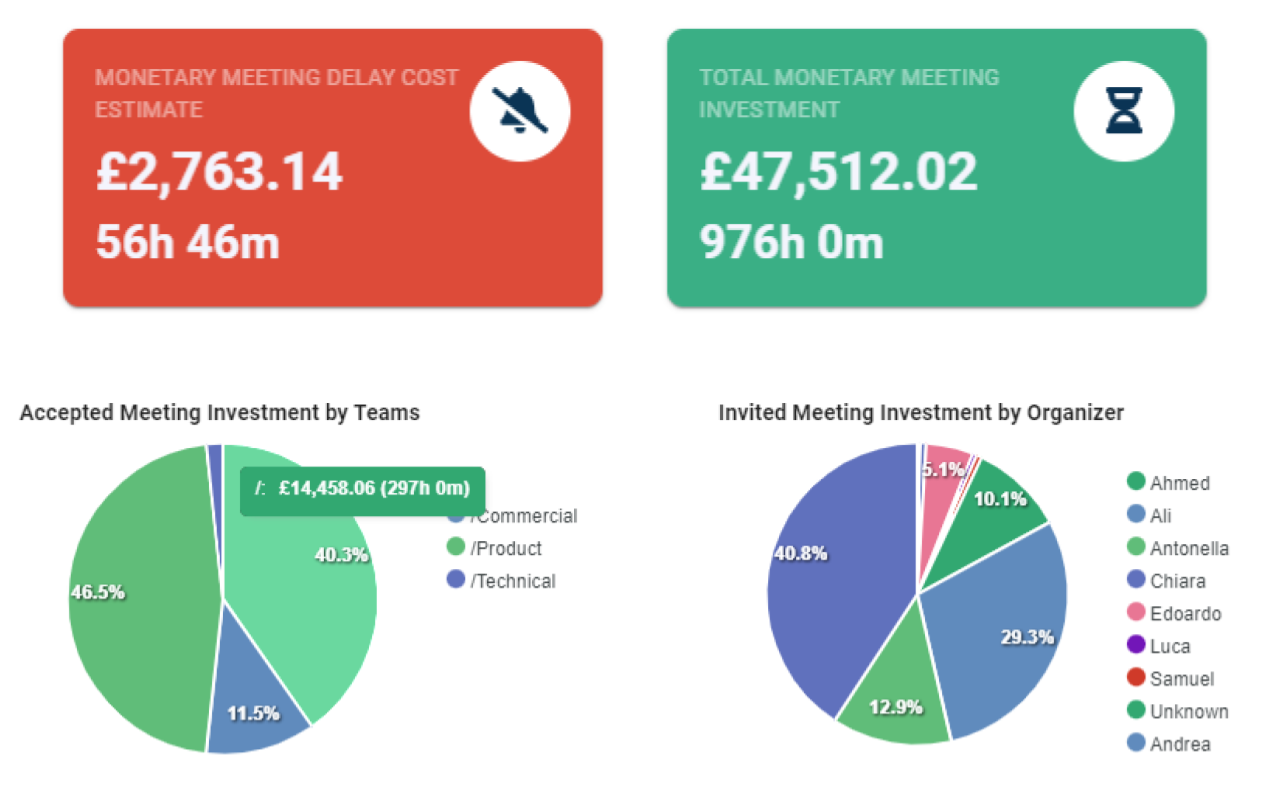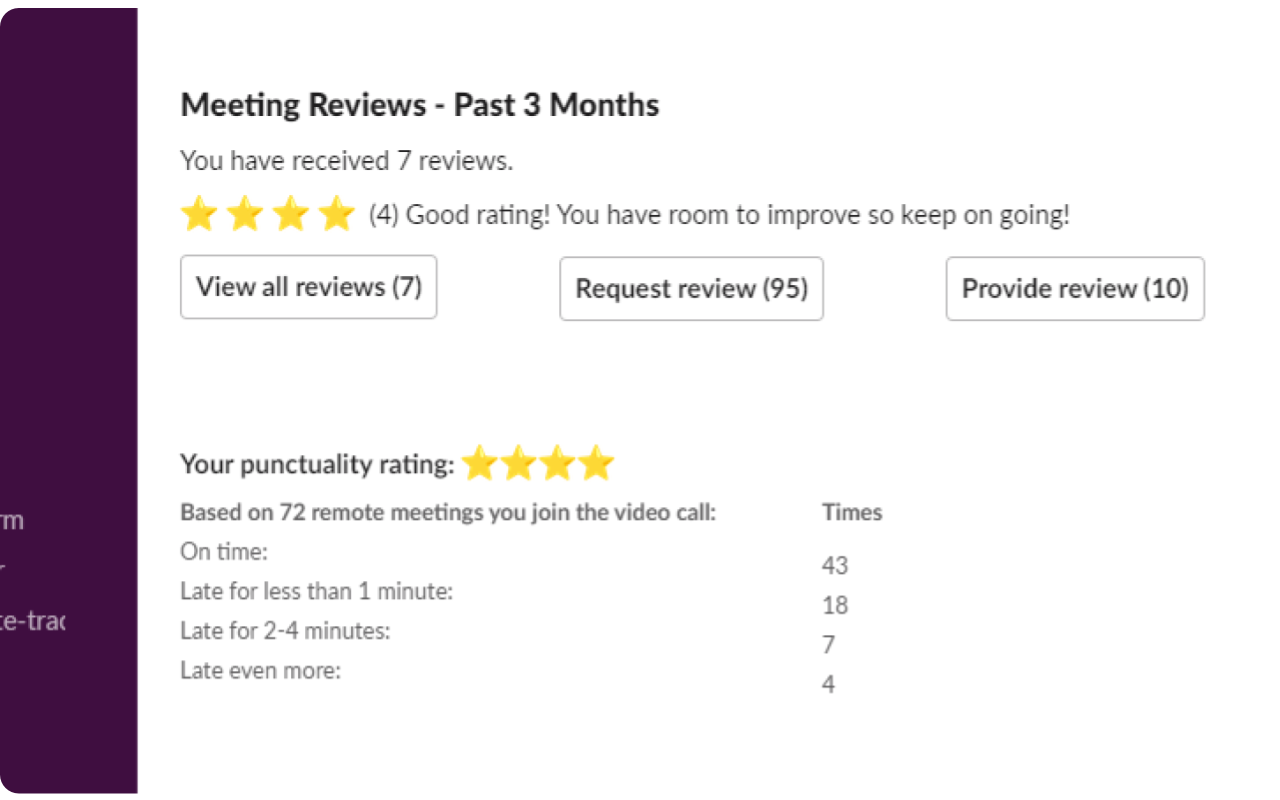A Guide to Optimizing Meetings with Flowtrace Meeting Analytics
Optimize meetings with Flowtrace Meeting Analytics to address common pain points, enhance efficiency, and drive team engagement. Learn how to improve...
Discover how meeting analytics can tackle meeting overload, boost productivity, and revolutionize collaboration in the workplace. Gain insights on the true cost of excessive meetings and explore solutions with Flowtrace.
Picture a standard workweek in the tech industry. It's characterized by a series of back-to-back meetings, continuous discussions, and a relentless stream of calendar alerts. Meetings have become a necessary evil, consuming precious time and often leaving professionals feeling exhausted and unproductive. Indeed, executives now spend nearly 23 hours per week in meetings, a dramatic increase from previous decades, signaling a huge increase in meeting overload. But what is the real cost?
As the demands of the contemporary workplace continue to rise, it's essential to find a way to escape the cycle of unproductive meetings and reclaim our time. This is where the power of meeting analytics comes into play. By harnessing the strength of data-driven insights and actionable recommendations, meeting analytics provides a systematic method to understand and enhance your meeting culture. It offers the chance to reveal hidden patterns, pinpoint inefficiencies, and revolutionize the way we collaborate and make decisions.
In this blog post, we'll delve into the common challenges associated with excessive meetings, such as meeting overload, lack of productivity, and missed opportunities for deep thinking. We'll also emphasize the importance of visibility and metrics in understanding the impact of meetings on organizational performance. By gaining actionable insights and understanding meeting dynamics, businesses can prioritize improvements and drive positive change.
Finally, we'll explore the key principles and strategies behind meeting analytics, demonstrating how Flowtrace, a leading provider of meeting analytics solutions, can transform your meeting culture. With the expertise and innovative tools provided by Flowtrace, you'll be equipped to make data-driven decisions, optimize meeting efficiency, and foster a culture of productive collaboration.
But first, let's delve into the real cost we pay for excessive meetings in our professional lives.
The prevalence of excessive meetings has become a growing concern in organizations across various industries. Professionals find themselves dedicating a significant amount of time to meetings, often at the expense of their productivity. The average number of meeting hours has nearly doubled in recent years, with executives dedicating a substantial portion of their workweek to meetings. This rise in meeting hours raises questions about the impact on overall productivity and the efficient use of valuable work time.

The cost of excessive meetings extends beyond the hours spent in conference rooms. In fact, unproductive meetings can have a significant financial impact on businesses. Research indicates that organizations in the United States lose billions of dollars annually due to wasted meeting time. These financial losses underscore the urgent need for organizations to evaluate their meeting culture and explore strategies for optimizing meeting efficiency.
Excessive meetings can negatively impact employee engagement and morale. Constantly being tied up in meetings can lead to feelings of overwhelm and reduced job satisfaction.

When employees spend a substantial amount of time in unproductive meetings, they may feel hindered in accomplishing their core responsibilities and contributing meaningfully to important projects.
This, in turn, can negatively impact employee engagement and the overall work environment.
With an overwhelming number of meetings, professionals may struggle to find adequate time for critical thinking and decision-making. Back-to-back meetings can limit the opportunity for deep analysis, resulting in delayed decision-making and missed opportunities for innovation and progress. The constant demand for attending meetings can hinder professionals from dedicating focused attention to strategic and value-added tasks.
Not only are meetings increasingly abundant, but their durations have also seen a noticeable increase. The average length of meetings has expanded over the years, leading to longer periods of time dedicated to discussions and decision-making. Extended meeting durations can contribute to diminishing engagement, as participants' attention spans are stretched thin, potentially resulting in reduced effectiveness and outcomes.
The costs associated with excessive meetings necessitate a focus on meeting optimization and efficiency. Organizations must strive to reduce unnecessary meetings and streamline their duration to maximize productivity and enhance the efficient use of time. By implementing strategies to optimize meetings, businesses can unlock productivity gains, increase employee satisfaction, and foster a more effective and collaborative work environment.
Now that we have examined the various costs of excessive meetings, let's shift our focus to potential solutions.
Meeting overload is a widespread challenge that organizations face, hindering productivity and impeding progress. The constant stream of meetings can leave employees feeling overwhelmed and struggling to find time for critical tasks. It is crucial to address this issue and find effective solutions to optimize meeting practices and alleviate the burden of excessive meetings.
Research conducted by Harvard Business Review underscores the significant productivity gains that can be achieved by reducing meeting frequency. The study found that employee productivity increased by 71% when meetings were reduced by 40%. Unleashing this potential is now possible by implementing effective meeting analytics strategies.
Meeting analytics offers a powerful tool to tackle meeting overload and increase productivity. By leveraging data-driven insights and advanced analytics, organizations can identify inefficiencies, streamline processes, and make informed decisions to optimize their meeting culture. This approach allows for a more strategic and purposeful approach to meetings, reducing unnecessary gatherings and ensuring that the meetings conducted are valuable and impactful.
Meeting analytics enables organizations to analyze meeting durations and identify opportunities for streamlining and shortening meetings. By understanding average meeting lengths and identifying time-consuming discussions, organizations can establish guidelines for meeting duration, encourage focused conversations, and create more efficient meeting structures. This optimization allows participants to make the most of their time, freeing up valuable resources for other essential tasks.

Through meeting analytics, organizations can gain insights into meeting attendance rates, engagement levels, and outcomes. This data-driven approach helps identify unnecessary meetings that can be eliminated or replaced with more effective alternatives. By prioritizing essential discussions and leveraging asynchronous communication or targeted collaboration tools, organizations can reduce meeting overload while still achieving desired objectives.
In addition to the number and length of meetings, another important aspect of meeting productivity of course is the quality of the meeting. Meeting analytics provides valuable insights that enhance meeting preparation and facilitation. By understanding participant behaviors, contribution patterns, and topic trends, organizations can improve meeting preparation, ensuring that the right people are involved, relevant materials are shared, and agendas align with meeting objectives.
This level of preparation fosters more productive discussions, reduces time wasted on irrelevant topics, and enhances overall meeting outcomes. We discuss the cost of poor meeting quality and tips on how to run effective meetings more in our other posts.
Flowtrace's meeting analytics offer organizations a wealth of actionable insights to drive informed decision-making. With its advanced data analysis capabilities and AI-driven recommendations, Flowtrace empowers organizations to make data-driven decisions for enhanced productivity and collaboration. By leveraging Flowtrace's platform, organizations gain valuable insights into their meeting culture, enabling them to identify patterns, trends, and areas of improvement.
Flowtrace provides comprehensive analytics on meeting performance, tracking key metrics such as attendance rates, engagement levels, and contribution patterns. These metrics offer organizations a clear understanding of their meeting effectiveness and serve as a foundation for making informed decisions to optimize meeting outcomes.
Flowtrace's platform is designed to streamline meeting processes and enhance efficiency. Through its analytics capabilities, Flowtrace reveals patterns and trends across multiple meetings, departments, or the entire organization. Flowtrace helps to identify inefficiencies and bottlenecks that hinder productivity and highlights areas for improvement, such as excessive meeting durations, low engagement, or unproductive meeting topics. Armed with these insights, organizations can implement targeted strategies to optimize meeting duration, improve engagement, and ensure that meetings are focused and purposeful.
One of the key benefits of Flowtrace's meeting analytics platform is its ability to foster a culture of continuous improvement. Traditionally, reviewing meeting practices requires performing a time-consuming meeting audit. With Flowtrace, this process is automated and always up-to-date, enabling organizations to focus on continuous improvement instead.

By collecting feedback from meeting participants and monitoring meeting performance, Flowtrace provides valuable insights that inform iterative changes, ensuring that each meeting becomes more productive and aligned with organizational goals.
Flowtrace empowers organizations to optimize meeting resources and allocate time effectively. By analyzing meeting data, organizations can assess the return on investment of each meeting and make informed decisions about resource allocation.
Flowtrace's platform helps organizations identify opportunities to streamline meetings, reduce unnecessary "time wasting gatherings", and allocate time more efficiently. This data-driven approach ensures that meetings are purposeful, focused, and aligned with organizational priorities.
Flowtrace's meeting analytics platform revolutionizes the way organizations approach meetings. By leveraging the platform's advanced capabilities, organizations can overcome meeting overload and unlock the true potential of their teams.
Flowtrace empowers organizations to optimize meeting processes, drive productivity enhancements, and foster a culture of collaboration and success. With Flowtrace, organizations can transform their meeting practices, enabling more productive, efficient, and impactful meetings.
Flowtrace provides a meeting cost calculator for both Google Calendar and Outlook, designed to help leaders quantify the true cost of their meetings. By integrating with these calendar tools, Flowtrace allows users to see the financial impact of their meetings based on the duration and attendee count, in real-time.
This helps organizations identify unproductive meetings and manage meeting overload effectively, promoting a more efficient meeting culture. It also offers actionable insights and recommendations to optimize meeting practices, ultimately contributing to improved productivity and resource management.
By providing detailed meeting analytics, particularly on meeting costs, Flowtrace empowers leaders to make informed decisions about their meeting practices.
Throughout this article, we have explored the challenges and costs associated with excessive meetings. We have discussed how meeting analytics offers a data-driven solution to optimize meeting practices, increase productivity, and foster collaboration. By leveraging the power of data insights and actionable recommendations, organizations can make informed decisions, streamline meeting processes, and unlock the true potential of their teams.
Flowtrace's meeting analytics platform stands out as a leading provider in this space. With its advanced data analysis capabilities, AI-driven insights, and comprehensive tracking of key meeting metrics, Flowtrace empowers organizations to overcome meeting overload and revolutionize their meeting practices. By harnessing the power of Flowtrace's platform, organizations can gain actionable insights, optimize meeting duration, enhance engagement, and drive continuous improvement in their meeting culture.
So, whether your organization is struggling with meeting overload, unproductive practices, or a lack of visibility into meeting effectiveness, meeting analytics can be the catalyst for positive change.
Optimize meetings with Flowtrace Meeting Analytics to address common pain points, enhance efficiency, and drive team engagement. Learn how to improve...
Transform unproductive meetings with actionable insights and improve productivity and collaboration with Flowtrace's meeting analytics solutions....
Expert Meeting Preparation Tips and Tricks from Flowtrace's meeting analytics team on how to prepare for a meeting like a pro.